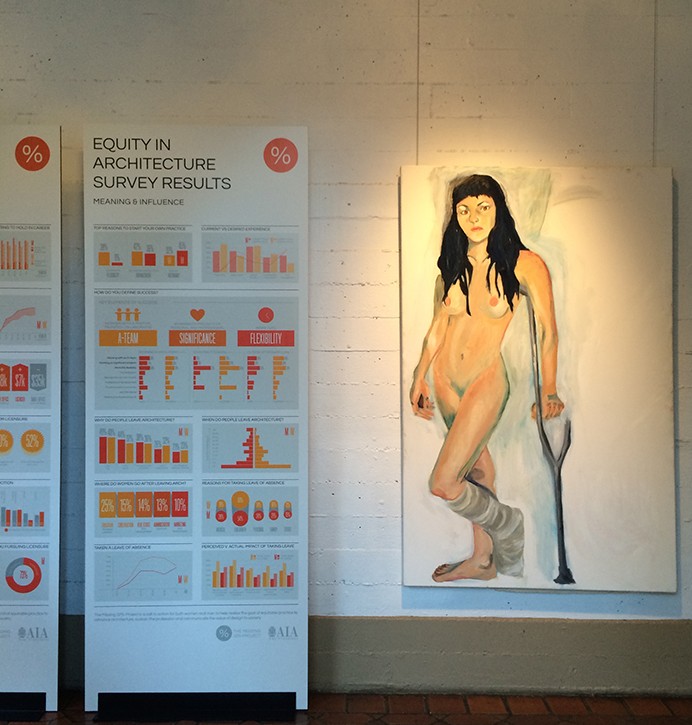Recap: Equity by Design Symposium A Call to Action
by Heather McKinstry Editor's Note: Be sure to catch Rosa Sheng in New York at the Center for Architecture Foundation on February 27, 2015. Details here!
The Missing 32% Equity by Design Symposium, held on October 18, 2014, at the San Francisco Art Institute, was an enlightening, fact-filled conversation about the underrepresentation of women in the architecture profession. Spearheaded by Rosa Sheng AIA, the symposium built on a survey that the Missing 32% conducted from February to March 2014 to better understand our industry's gender gap. The survey had three parts, which became the three main topics of the symposium: Hiring & Retention, Growth & Development, and Meaning & Influence. Conversation focused on the pertinent issues of job satisfaction, equal pay, and work-life flexibility.
The "Missing 32%" refers to the fact that men and women have been entering architecture school in equal numbers for many years, but as this survey and others have shown, only 18% of licensed architects are women. Equity by Design identified possible factors contributing to the attrition rates such as women receiving lower pay, even at the intern level, women shouldering more responsibility for not only childcare, but also as extended family caregivers, and lack of role models.
Praising the use of surveys to approach gender disparity, Aidan Hughes, Principal/Group Leader at Arup pointed out that while narratives can be compelling, statistics are harder to ignore. No matter how compelling the story, a narrative can be dismissed as an isolated incident. The Missing 32% survey provided a factual, rather than personal, jumping off point for discussion. The data made clear that promoting equity in the profession is not just as a moral obligation, but also a business imperative, as architecture cannot afford to ignore these alarming attrition rates.
Much of the conference focused on the shift in the profession from the stereotype of the sole practitioner toiling away by himself. The next generations of architects are forming collaborative, multidisciplinary teams that stretch the definition of what an architecture firm can be. Architects at the conference talked about their work as an ‘Architect and (fill-in-the-blank)’ with complementary projects ranging from user experience design and product design to branding and capital asset management. These new markets were driven by economic opportunity, particularly in San Francisco and provided stability during the recession.
While the approach of increasing flexibility has gained ground as an equalizer for those whose roles are often defined as "professional and mom," the concept was stretched further here to include architects who find meaning both in their work and in other roles outside of the family and studio. This view expands the appeal of flexibility beyond primary care givers. By providing flexible schedules and supporting employees outside endeavors, through resource sharing, hosting maker faires, and genuine encouragement, architecture firms can extend their reach into new territories, and build teams with unique approaches to problem solving and diverse skill sets and knowledge.
The appeal of the ‘Architect and (fill-in-the-blank)’ concept is that it begins to reveal potential solutions to the problems identified by the survey, like lack of job satisfaction throughout the industry. Hiring a staff with diverse interests may be a way to overcome unconscious biases and result in a more diverse staff. By allowing each staff member to bring a unique perspective to the table and be the resident expert on that topic, the confidence of the employee is built up by a series of small wins, an important part of professional growth. Those employees can form a strong team that can communicate well with each other as well as with clients.
The notion that work-life balance is becoming about more than childrearing was reaffirmed in the closing session. Stewart Friedman referenced his own research, in which he found that in 1992, 78% of the Wharton Business School students he surveyed answered yes, they want to have children, while in 2012, only 42% answered yes to the same question. While some may find this statistic surprising, it points to the fact that having children is no longer the default for women, or men. With more choices and evolving social norms, individuals are making very different choices than were common 20 years ago.
The symposium was an uplifting step in the burgeoning movement towards equity, but also emphasized that there is still much work to be done. As is the case in many professions, the survey revealed inequity in the form of salary, where men out-earn women, and not just at the peak of their careers, when men make an average of $15,000 a year more than women, but from day one, when male interns make an average of $4,000 a year more than their female counterparts, despite neither having any previous experience.
The Equity by Design symposium was a call to action. It was the distribution of a set of tools that architects can use to identify and confront this problem, and to support the building of a community that believes in education and transformation.
"If you see inequity, name it. If you see privilege, talk about it" - Emily Grandstaff-Rice, AIA
For further reading: The Missing 32% http://themissing32percent.com.
Heather McKinstry is an architect and the co-founder of Sprout Farms, an urban agriculture education non-profit organization. After graduating from Rhode Island School of Design, Heather worked on Bushwick Inlet Park and Bronx River House as well as other sustainable projects at Kiss+Cathcart, Architects. As a project architect at Loci Architecture, Heather is overseeing the construction administration of a 15 story affordable housing project in the Bronx and a charter school renovation in Brooklyn.
Join her Women in Architecture/Urban Planning Meetup! http://www.meetup.com/Women-in-Architecture-Urban-Planning/




